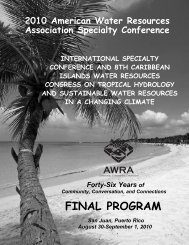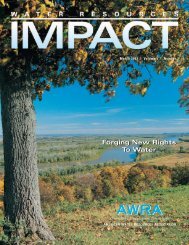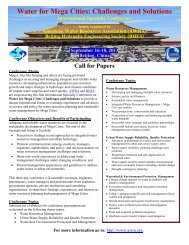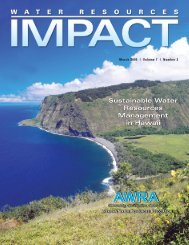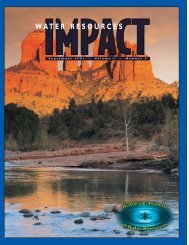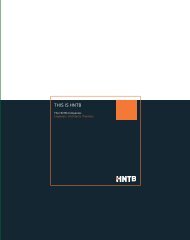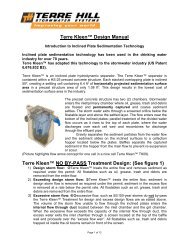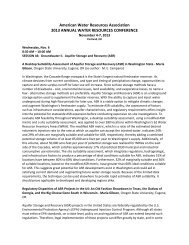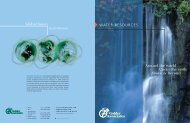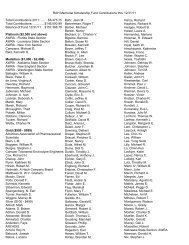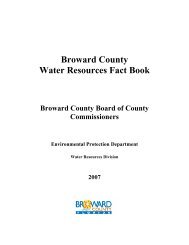N ovember 2 0 0 0 ⢠V olume 2 ⢠N umber 6 - American Water ...
N ovember 2 0 0 0 ⢠V olume 2 ⢠N umber 6 - American Water ...
N ovember 2 0 0 0 ⢠V olume 2 ⢠N umber 6 - American Water ...
Create successful ePaper yourself
Turn your PDF publications into a flip-book with our unique Google optimized e-Paper software.
Blue Baby Syndrome and Nitrates: New Research Casts Doubt on an Old Regulation . . . cont’d.<br />
exposure-from zero ppm nitrate-nitrogen upward-and<br />
that diarrhea and gastrointestinal problems are the real<br />
cause. The medical literature includes reports of cyanosis<br />
associated with diarrhea as far back as 1904.<br />
Moreover, the APHA survey data on which most of<br />
the world’s regulation is based was of poor quality and<br />
extremely limited scope: in many instances the samples<br />
of water for analysis were collected several months after<br />
the case; many of the reported blue baby cases were<br />
never definitively diagnosed by a doctor; and the survey<br />
did not report the presence of nitrite, bacterial contamination,<br />
diarrhea, or gastrointestinal disease (Walton,<br />
1951).<br />
CONCLUSION<br />
There is little question that high levels of nitrates in<br />
drinking water can contribute to the severity of blue baby<br />
syndrome. What constitutes “high nitrate levels” is open<br />
to debate. Most blue baby cases reported in the literature<br />
occurred at water nitrate concentrations above 40 ppm.<br />
I have argued, based on extensive review of blue baby research<br />
and a century’s worth of case reports, that the<br />
drinking water nitrate standard could be raised to 15 or<br />
20 ppm without increasing the risks to infants.<br />
The problem with any recommendation is the fact<br />
that blue baby syndrome can occur with zero nitrate exposure,<br />
which creates a conundrum: how does one measure<br />
the impact of nitrates on the severity of a blue baby<br />
case in order to establish a nitrate standard? This debate<br />
is further muddled by decades of entrenched beliefs and<br />
a regulatory system that abhors change. Thus, the debate<br />
is unlikely to be settled anytime soon.<br />
It is clear, however, that limiting nitrates in drinking<br />
water is not the best approach to preventing blue baby<br />
syndrome. The best approach would be to prevent and<br />
treat the illnesses that actually cause blue baby syndrome,<br />
such as bacterial and viral gastroenteritis. We<br />
should also educate parents, doctors, and public health<br />
officers that any infant less than six months of age with<br />
diarrhea or other gastrointestinal illness – especially low<br />
birth weight and premature babies – is at risk of blue<br />
baby syndrome. Recent studies indicate that mild to<br />
moderate blue baby syndrome is not uncommon among<br />
such infants and several serious cases have been documented.<br />
Finally, the most productive thing we could do is to<br />
conduct more research on blue baby syndrome – so that<br />
all of these unresolved questions can be properly answered.<br />
LITERATURE CITED<br />
Avery, Alexander A., 1999. Infantile Methemoglobinemia: Reexamining<br />
the Role of Drinking <strong>Water</strong> Nitrates. Environmental<br />
Health Perspectives 107 (7):583-586.<br />
Comly, Hunter H., 1945. Cyanosis in Infants Caused by Nitrates<br />
in Well <strong>Water</strong>. Journal of the <strong>American</strong> Medical Association<br />
129:112-116.<br />
Cornblath, M. and A.F. Hartmann, 1948. Methemoglobinemia in<br />
Young Infants. Journal of Pediatrics 33:421-425.<br />
Hegesh, E. and J. Shiloah, 1982. Blood Nitrates and Infantile<br />
Methemoglobinemia. Clinica Chimica Acta 125:107-115.<br />
Levine, J.J., M.M. Pettei, E. Valderrama, D.M. Gold, B.H.<br />
Kessler, and H. Trachtman, 1998. Nitric Oxide and Inflammatory<br />
Bowel Disease: Evidence for Local Intestinal Production<br />
in Children with Active Colonic Disease. Journal of Pediatric<br />
Gastroenterology Nutrition 26(1):34-38.<br />
Snow, John, 1855. On the Mode of Communication of Cholera,<br />
(2nd Edition). John Churchill, London, England.<br />
Walton, G., 1951. Survey of Literature Relating to Infant Methemoglobinemia<br />
Due to Nitrate-contaminated <strong>Water</strong>. <strong>American</strong><br />
Journal of Public Health 41:986-996.<br />
AUTHOR LINK<br />
E-MAIL<br />
Alex Avery, Director of Research<br />
Hudson Institute<br />
Center for Global Food Issues<br />
P.O. Box 202<br />
Churchville, VA 24421<br />
(540) 337-6354 / Fax: (540) 337-8593<br />
aavery@rica.net<br />
Alex Avery is Director of Research at the Hudson Institute’s<br />
Center for Global Food Issues. This article is a synthesis<br />
of a review Alex authored that was published in<br />
July 1999 in Environmental Health Perspectives, a peerreviewed<br />
publication of the National Institutes of Environmental<br />
Health Sciences. Alex has written on agricultural,<br />
food safety, regulatory, and global population issues<br />
for major newspapers, including The Wall Street<br />
Journal, The Washington Times, St. Louis Post-Dispatch,<br />
Fort Worth Star-Telegram, and the Des Moines Register.<br />
He has also been published in USA Today magazine, Regulation<br />
magazine, and the Journal of the <strong>American</strong> Dietetic<br />
Association. His article on international food regulations<br />
will appear in the Wiley Encyclopedia of Food Science<br />
& Technology (Second Edition).<br />
❖ ❖ ❖<br />
Submitting Articles for IMPACT . . .<br />
Contact the Associate Editor who is working on an<br />
issue which addresses a topic about which you wish to<br />
write. Associate Editors, their e-mail addresses, and<br />
their topics are listed on pg. 1. A less direct approach<br />
would be to contact the Editor-In-Chief Earl Spangenberg<br />
and let him know your interests and he can connect<br />
you with an appropriate Associate Editor. Our target<br />
market is the “water resources professional” – primarily<br />
water resources managers and such people as<br />
planning and management staffers in local, state, and<br />
federal government and those in private practice. We<br />
don’t pay for articles or departments. Our only recompense<br />
is “the rewards of a job well done.”<br />
V<strong>olume</strong> 2 • N<strong>umber</strong> 6 <strong>Water</strong> Resources IMPACT • 13



